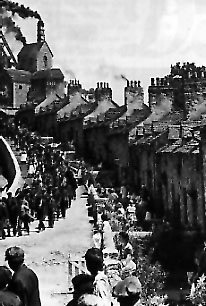
Photography: Capturing Souls
 |
||
| John Ford knew the power of the image in controlling the viewer's point of view. In this image from How Green Was My Valley, what element is dominant? What element is oppressed? | ||
In Judeo-Christian belief, the Second Commandment states: "Thou shalt not make unto thee any graven image or any likeness of any thing that is in the heaven above, or that is in the earth beneath, or that is in the water under the earth…" That’s pretty straightforward—and comprehensive. There are people who interpret the Second Commandment as prohibiting the making of any images whatsoever. (Obviously, you aren’t one of them or you wouldn’t be taking this course!)
This veneration of images is not limited to the Judeo-Christian tradition, either. There are also old stories about aboriginal tribesmen believing that a photograph can steal your soul. We’ll leave a discussion of why images have such holy power to the psychologists and philosophers. For our purposes it is enough to recognize that, for thousands of years, images of people or of things have been considered so remarkable, mysterious, and influential, that they take on religious import of the highest order.
We don’t know what Moses would have thought of Edison’s phonograph, but it is likely that sound recordings would have been treated with less awe than visual images. There is an equivalence in sound recording that is not shared with image recording. In other words, you can do a lot more to the image than to the sound to change a viewer’s perception—a fact that was understood by cinematic greats like director/writer/actor John Ford, and that The Terminator shows as well as Michelangelo’s Creation of Adam on the ceiling of the Sistine Chapel.
|
The
Author Reflects: French filmmaker and ethnographer Jean Rouch has been widely praised for his film records of African tribal life. For more than 30 years, he patiently recorded rituals and folkways of tribes who had no written record of their culture. You’d think this was an admirable undertaking. In the early ‘80s, I met someone who had worked with Rouch on several shoots in central Africa. By this time, Rouch had been working with the same groups for more than 20 years. But something strange and unexpected had happened, she explained to me. Now, the younger members of the tribe were watching Rouch’s records of their parents’ rituals to learn how to do them "correctly"! For thousands of years, the rituals had been passed down from generation to generation. Inevitably, they changed, grew, and developed as one generation succeeded another. Now they were frozen in time, in the 1960s or 1970s—whenever Jean Rouch had chanced to record them. What Rouch had sought to preserve―the fluid change of a culture’s rituals―he had unwittingly killed by capturing it on film as it was at one specific time!
—James Monaco
|
On the most basic level, a filmmaker (or a photographer or a painter) controls your point of view. You may not always be aware of that, but it is always true. If a director chooses to shoot from a high angle, the subject is belittled; if he chooses to shoot from a low angle, the subject is enhanced. A long shot sets the subject in the context of the environment; a close-up separates the subject from the environment. A shot of two people suggests a dialogue or relationship between the characters (even when they don’t speak). A telephoto shot compresses depth, integrating the subject into its environment; a wide-angle shot does the reverse, separating the subject from several planes of the environment. A pan, zoom, or tracking shot invites the audience to get involved in the scene, and often makes a logical point about the relationship between the subject and the scene. If the filmmaker frames the shot so the subject is off-center, that suggests that someone else is involved in the scene (even though we don’t see them); if the subject is centered, we don’t think about an interlocutor. If the shot is dark, we have to work harder to get involved; if the scene is lit with bright key lighting, we relax and sit back.
These are just a few examples of the power the filmmaker has over the subject. We have an intimate relationship with the subject—but it is molded and controlled by the filmmaker. (We’ll revisit many of these techniques for establishing a point of view in future lessons.) As the technology of film (and photography) developed, the filmmaker had increasing control over our relationship with the subject. In the 19th century, when film was very slow, it was hard to capture the live image of a subject. Early daguerreotypes are rigidly posed; the subject had to be immobile for the many seconds that it took to take the picture. It was nearly impossible then to capture a moment out of real life, a moment when the subject was moving. The earliest film confronted the same problem. As the speed of filmstock (and therefore, the ability to capture an image "on the fly") increased, cinema became infused with life. We take this for granted today but it is good to remember that early filmmakers had enough trouble capturing the bodies of their subjects—much less the expressions on their faces.
Film is not reality. It is an approximation of reality. As the technology develops, the approximation becomes more detailed.
So images, whether moving or still, have a spiritual power and a psychological effect that is very important―not just to the creators of those images, but also to the people looking at them. Let’s delve a little deeper into why and how this is true.